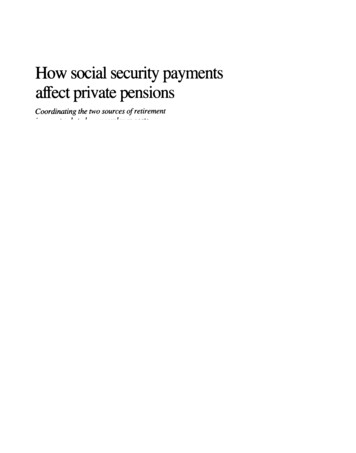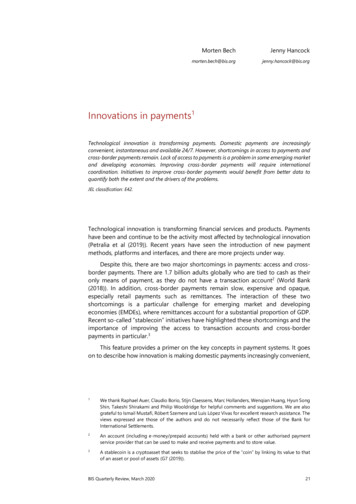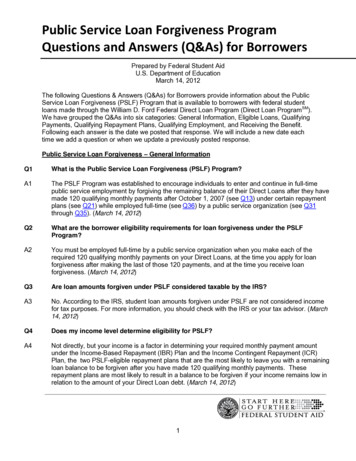
Transcription
How social security paymentsaffect private pensionsCoordinating the two sources of retirementincome tends to lower employer costsfor private pension plans, and resultsin private pensions which replace a larger percentageofpreretirement earnings for higher paid workersDONALD BELL AND DIANE HILLMany workers look forward to receiving benefits from private pension plans as well as from social security . Half ofall full-time wage and salary workers in private industry inMay 1979 were covered by pension plans ;' nearly all ofthem were also under the social security system . This dualretirement income has fostered interest in coordinating public and private plans . Often, social security payments areconsidered when setting the terms of private pension plans .There are two types of private pensions plans: definedcontribution plans, which require an employer to contributea specified amount of money into a pension fund ; and defined benefit plans, which provide specified benefits according to a formula taking into account an employee's yearsof service, or earnings, or both . A defined contribution plandoes not promise a predetermined level of benefits-thebenefits paid at retirement depend on the amount creditedto an employee . In a defined benefit plan, pension benefitsare predetermined and the employer must make contributions adequate to finance those benefits . Both types of plansmay reflect the existence of social security (Old-Age, Survivors, and Disability Insurance) either implicitly, by informally providing lower annuities than would be the caseif social security benefits were not available; or explicitly,by formally recognizing the existence of social security .zPlans which explicitly acknowledge social security benefits are called integrated plans . Their formulas generallyrecognize not only the level but also the underlying structureof social security benefits . For example, social security benefits as a percent of preretirement earnings (replacementrates) are greater for low-wage earners than for high-wageearners. Some employers counter this difference by using aDonald Bell and Diane Hill are labor economists in the Office of Wagesand Industrial Relations, Bureau of Labor Statistics .benefit formula which results in greater replacement ratesunder the private plan for high-wage earners. Internal Revenue Service regulations, discussed later, govern the extentto which this is permissible .Proponents of integrated private plans maintain that coordinating private pensions and social security benefits yieldsequitable retirement income for all workers, regardless ofearnings, while keeping employer costs within reasonablebounds . (Employers often contend that their payment ofsocial security taxes should be considered when determiningoutlays for private benefits . ;) On the other hand, criticsstress that integrated private plans may provide low benefits-or none at all-to low-wage earners.'Information on integrated private pension plans was obtained from the Bureau of Labor Statistics' annual surveyon the incidence and characteristics of employee benefitplans in medium and large firms .' Of the 914 defined benefitpension plans studied in 1981, 521, or nearly three-fifths,were integrated . Most of the integrated plans (60 percent)reduced private pensions by a portion of the social securitypayment. The remainder (40 percent) were coordinated withsocial security through percent-of-earnings benefit formulasthat applied different percentages to earnings above andbelow specified dollar levels .Defined benefit plans which integrate by deducting a portion of the social security payments are called offset plans .Those which establish higher pension formulas for earningsabove a specified level than for those below are called excessplans; the earnings level is related to the maximum wagesubject to social security taxation (the "taxable wage base"),which was 29,700 in 1981 . (Integrated defined contributionplans, excluded from this study, follow the excess approach ;contribution rates, expressed as a percent of earnings, arehigher on earnings above a specified level than below.)15
MONTHLY LABOR REVIEW May 1984 a Social Security Payments and Private PensionsOffset plansSixty percent of all the integrated plans included in thestudy were offset plans. The formula in an offset plan andits effect on replacement rates (annuity as a percent of earnings in the final year of work) are illustrated in the following:Two employees retired at the beginning of 1981 after 30years of service; one earned 20,000 in 1980 and the other, 30,000. Both employees were covered by a private pensionplan with a typical offset provision which provides pensionsequal to 1 .5 percent of average earnings in the five highestearnings years ("high-five" average earnings) multipliedby years of service, less 50 percent of primary social securitybenefits (excluding benefits for spouses or other dependents) . The workers' earnings were not constant over theyears. Therefore, it is necessary to estimate their earningsin each of the years affecting the private pension and socialsecurity benefit calculations . The estimated "high-five" average earnings used here were calculated from assumedearnings histories developed by the Social Security Administration, which also provided the social security benefits .Replacement rates were calculated by dividing each benefitby the workers' earnings in the last year of work .'Glossary of pension termsAnalysis of pension plan provisions is complicated bytechnical terms which permeate the pension literature .The use of these terms cannot be avoided . However,each of the technical terms used in this article is definedbelow.Career earnings formula . A formula which bases pension benefits on average earnings in all years of creditedservice .Defined benefit plan . A pension plan which includes aformula for calculating retirement benefits (such as aspecified percent of earnings or flat dollar amount peryear of service) and obligates the employer to providethe benefits so determined . Therefore, employer contributions are not fixed, but are whatever is needed, togetherwith earnings of pension fund investments, to financethe required benefits .Defined contribution plan . A pension plan that obligates the employer to contribute money to a pension fundaccording to a formula (such as a specified percent ofearnings). Benefits are not fixed, but depend on the amountof employer contributions and the earnings of pensionfund investments .Early retirement . Retirement before the normal retirement age . Early retirement pensions depend on earningsand service, but are reduced for each year prior to thenormal retirement age .Excess plan . An integrated pension plan which provides relatively higher pensions on earnings above a specified level than on earnings below that level . A pureexcess plan calculates pensions only on earnings abovethe specified level, while a step-rate excess plan hasseparate calculation formulas for earnings above and below the specified level.Flat-benefit plan . An excess plan that expresses pensions as flat percentages of earnings, independent of lengthof service .16Integrated pension plan . A private pension plan that isexplicitly coordinated with social security, either throughthe offset or excess approach . A common objective is torecognize employer costs for social security in settingprivate pension benefits . In addition, integrated privatepension plans often provide greater benefits relative topreretirement earnings for the higher-paid workers.Integration level (breakpoint) . The level above and below which excess plans apply different percent-of-earnings formulas . The integration level may be the "socialsecurity taxable wage base" or a specified dollar amount,usually the taxable wage base at the time the excessformula was developed.Normal retirement . Retirement at the earliest age specified in a pension plan for retirement with all accruedpension benefits by virtue of earnings and service, without reduction due to age .Offset plan . An integrated pension plan that reducesprivate benefits by a portion of an employee's socialsecurity benefit .Old-Age, Survivors, and Disabilit r Insurance(OASDI) . The old-age insurance program established bythe Social Security Act, referred to as "social security"in text .Replacement rate . Retirement annuity as a percent ofearnings in the final year of work .Taxable wage base . The maximum wage or salary subject to payroll taxation for social security purposes . Thewage base was 29,700 in 1981, the year covered bythis study.Terminal (final) earnings formula . A formula that basespension benefits on average earnings in the final yearsof credited service-often the last 3 or 5 years .Unit benefit plan . An excess plan that expresses pensions as percentages of earnings per year of service.
20,000 30,000Earnings in last year of work . . . . . . . . . ."High-five" average earnings . . . .Private pensions, before offset17,11925,683Replacement rate . . . . . . . . . . . . . . . .(1) x .015 x 30 . . . . . . . . . . . . .7,70411,557(3) Social security benefit . . . . . . . . . . .Replacement rate . . . . . . . . . . . . . . . .38 .57,88439 .48,12427 .1(2) - '/2 of (3) . . . . . . . . . . . . . . .Replacement rate . . . . . . . . . . . . . . . .Offset pension plus social security(4) (3) . . . . . . . . . . . . . . . . . . . .3,76218 .87,49525 .011,64615,619(1)(2)(4)(5)Private pension, after offset58 .2Replacement rate . . . . . . . . . . . . . . . .38 .552 .1Prior to calculation of the social security offset, privatepensions replace 38 .5 percent of preretirement earnings forboth the 20,000 and the 30,000 worker (2). However,after deducting half the social security benefit paid to theseworkers, the 30,000 worker receives a greater private pension proportionate to preretirement earnings than does the 20,000 worker (4) . But the replacement rate for combinedsocial security and offset private benefits is higher for the 20,000 worker ; this stems from the social security benefitformula, which yields a higher replacement rate for the 20,000 worker, (3) and (5).Offset plans use a variety of approaches to determine thesocial security deduction . (See table 1 .) One-fourth of theoffset plans in the 1981 study specified deductions independent of an employee's length of service: they generallyTable 1 . Incidence of social security integration Indefined benefit plans by type of formula, private pensionplans in medium and large firms, 1981Pension benefits formulaIntegration Defined benefit plans :Number . . . . . . . . . . . . . . . . .Percent . . . . . . . . . . . . . . . . 66333Excess . . . . . . . . . . . . . . . . . . .Pure excess4 . . . . . . . . .Step-rate . . . . . . . . . . . . . .Integrated at social securitytax base breakpoint . . . .Integrated at specified dollarbreakpoint . . . . . . . . . .231222512454153121520-10933-43194094Percent with integrated formulaeOffset3 . . . . . . . . . . . . . .Based on service . . . . . .Not based on service . . .Flat percent . . . . . . . .Dollar amount. . . . . . . . .Percent without integrated formula111--1 Primarily plans providing stipulated dollar benefits per year of service or dollar schedules of benefits varying by length of service.called for flat percentage deductions, averaging 60 percentof primary social security benefits . However, a majority ofthe offset plans (three-fourths) specified a percentage deduction which varied with length of service. These percentage offsets ranged from 0 .75 percent to 5 percent peryear of service, but the effect of this formula was usuallylimited by either a ceiling on the size of the offset (usually50 percent) or a curb on the years of service included in thecalculation (typically 25 to 40 years) . In cases where deductions varied by length of service, offsets for retirementsafter 30 years of service averaged 49 percent of the primarysocial security benefit in capped plans; this was higher thanthe 33-percent average found in plans without a ceiling onthe maximum offset .' (It is possible that uncapped formulasinclude lower percent-per-year offsets in recognition of theirpotential impact on long-service employees retiring after 35years or more on the job .) In all cases, the amount of theoffset is fixed at the time of retirement and subsequentchanges in social security benefits, either legislated or costof-living adjustments, do not affect private pension payments .Excess plansTwo-fifths of the integrated pension plans were excessplans . These plans contained percent-of-earnings benefitformulas which applied a higher percentage rate to earningsabove a specified level (the breakpoint or integration level)than to those below . Excess plans achieve patterns of replacement rates relative to preretirement earnings similar tothose under offset plans . This is illustrated in the following:Two employees retired at the beginning of 1981 after 30years of service, with earnings in 1980 of 20,000 and 30,000. Their pension plan provided benefits per year ofservice equal to 1 percent of career average annual earningsup to 7,800, and 1 .5 percent of earnings above this level.(The estimates of social security benefits were provided bythe Social Security Administration ; estimates of career average earnings are based on the Social Security Administration's assumed earnings histories .)Earnings in last year of work . . . . . . . . . .(1)(2)Career average earnings . . . . . . . . . .Pension on earnings to 7,800(3)Pension on excess earnings9,34014,011 7,800 x .01 x 30 . . . . . . . . . .2,3402,340Earnings over 7,800 x .015 x 30 . . . . . . . . .6932,795(2) (3) ., . . . . . . . . . . . . . . . . . .3,0335,135(5)Social security benefit . . . . . . . . . . .7,8848,124(6)Pension plus social security(4) (5) . . . . . . . . . . . . . . . . . . . .10,91713,259(4)2Plans with integrated formulas may contain either minimum or alternative formulasTotal private pensionReplacement rate . . . . . . . . . . . . . . . .which are not integrated with social security benefits, or both . In plans with two integratedformulas, the formula yielding the larger benefit was tabulated.31ncludes private pensions offset by railroad retirement benefits .4All "pure" excess plans in this study integrated at a specified dollar breakpoint, ratherthan the social security taxable wage base .NOTE: Because of rounding, sums of individual items may not equal totals . Dashesindicate no plans in the category . 20,000 30,000Replacement rate . . . . . . . . . . . . . . . .Replacement rate . . . . . . . . . . . . . . . .15 .239 .454 .617 .127 .144 .217
MONTHLY LABOR REVIEW May 1984 " Social Security Payments and Private PensionsBecause the two workers had career average earnings exceeding the breakpoint, each obtained the same pensionbenefits at the 1-percent accrual rate (2) . However, the 30,000worker, with greater earnings above 7,800 received morebenefits from the 1 .5-percent rate (3) and, as a result, ahigher overall private pension replacement rate (4). Nevertheless, as in the offset plan example, the replacement ratefor combined social security and private benefits is higherfor the 20,000 worker than for the 30,000 worker (6).Excess plan formulas differ considerably in such areas asthe integration level and the formula components . Someplans specify the "social security taxable wage base" asthe integration level; others specify a dollar amount, typically the taxable wage base in effect at the time the pensionformula was adopted . Excess plans commonly calculatebenefits as a percentage of average annual earnings multiplied by years of service (unit-benefit plans) ; some, following Internal Revenue Service guidelines, calculate benefitsas a flat percent of earnings of retirees with 15 years ormore of service (flat-benefit plans) .A limited number of excess plans- I percent of all thepension plans studied-calculated pension benefits only onearnings above specified dollar breakpoints (pure excessplans) . The remainder contained separate pension calculation percentages for different earnings levels (step-rate plans) .Slightly more than half of the step-rate excess plans designated the "social security taxable wage base" as the integration level . Accordingly, they adjust automatically tochanges in this base . Most of these plans specified either acareer average of social security tax bases (68 plans) or thesocial security tax base in each year worked (28 plans) . Theremainder used the average social security tax base duringthe final 3 or 5 years of service . On average, step-rate excessplans integrating at the social security tax base providedbenefits per year of service equal to 1 .05 percent of earningsup to the tax base, and 1 .64 percent of higher earnings-aspread of 0.59 percentage points .'The remaining half of the step-rate excess plans integratedat a specific dollar figure . For the most part, these plans didnot regularly adjust the integration level to match changesin the social security tax base . For example, one plan specified a 6,600 breakpoint; it provided benefits equal to Ipercent of the first 6,600 of career average annual earningsand 2 percent of higher earnings, multiplied by years ofservice . The breakpoint in this instance was the 1966 socialsecurity taxable wage base ( 6,600) .Among the step-rate excess plans citing dollar amountsas breakpoints, the specified earnings level ranged from 3,000 to 24,000 per year and averaged 7,282 . Benefitsaveraged 0.99 percent of earnings below the breakpoint and1 .65 percent above, a spread of 0.66 percentage points .This was slightly more than the 0 .59 points under plansusing a social security tax base integration level .'18Alternative formulas and minimum benefitsIntegrated pension formulas may result in nominal privateannuities for low-paid or short-service employees. Many ofthe pension plans studied contained provisions to counterthis possibility . Two approaches were used . In the first, anintegrated plan specified a minimum level of private benefits ; in the second, a pension plan with an integrated formula also contained an alternative formula which was notintegrated with social security . The retiree's private annuityis based on the formula which yields the higher benefit.The following tabulation of the 521 integrated pensionplans in the 1981 survey indicates the relative importanceof plans with minimum benefit provisions and alternative,nonintegrated formulas . (Sums of individual items may notequal totals because some plans contained both minimumbenefits and alternative formulas .)Offset plansExcess plans310100 .0PureStep-rate7100 .0204100 .0Alternative formulas . .50 .06 .844 .557 .0-40 .76 .4or alternative formulas . .50 .043 .059 .3Number . . . . . . . . . . . . . . . . . . . .Percent . . . . . . . . . . . . . . . . . . . . .With minimum benefitsor alternative formulas . .Minimum benefits . . . .Without minimum benefits57 .035 .8Relation of formulas and integrationTable 1 shows the overall extent to which private pensionplans were integrated with social security . It also indicatesa strong relationship between the benefit formula of a privatepension plan and the incidence and form of integration . Forexample, integration was largely confined to private pensionplans which calculated benefits as percentages of preretirement earnings . Integration provisions were found in threefifths of the plans calculating pensions as a percentage ofcareer earnings and in four-fifths of those using terminalearnings formulas which base pensions on earnings in thelast years of service.Furthermore, terminal and career earnings plans use different approaches to integration . Career earnings plans typically used step-rate excess formulas, whereas the terminalearnings plans applied the offset approach in a majority ofthe cases.The incidence of integration declined substantially amongplans without career or terminal earnings formulas . Benefitswere coordinated with social security in 6 percent of the253 plans which did not have a percentage-of-earnings benefit formula; these plans mainly stipulated dollar benefitsper year of service or dollar schedules of benefits varyingby length of service.Influence of collective bargaining . Collectively bargainedpension plans tend to exclude integration provisions . Inte-
Table 2. Incidence of social security Integration indefined benefit plans, by collective bargaining status,private pension plans In medium and large firms, 1981Inltgrallon stabsUnion-managemeat plansAI plansNomenlon plansNumber Percent Number Percent Number PercentTotal defined benefit plans .914100280100634100With integrated formula 814393432398515424Offset . . . . . . . . . . .Excess . . . . . . . . . . .Pure . .Step-rate .Integrated at socialsecurity tax basebreakpoint . . . .Integrated at specifieddollar breakpoint .Without integrated formula310211720428519571884531130NOTE: Because of rounding, sums of individual items may not equal totals . Dashesindicate no plans in the category .grated formulas were found in 76 percent of the nonunionplans in the 1981 study, compared with 15 percent of theunion-management plans . (See table 2 .) This contrast helpsexplain the patterns shown in table 1 . Career and terminalearnings formulas--which generally are integrated-typically are found in nonunion plans . On the other hand, bargained plans-which generally exclude integrationprovisions-most commonly contain dollar amount for-mulas.The proportion of union-management plans in 1981 withintegration formulas is markedly below that recorded in twoearlier Bt,s analyses . 10 A study of 300 pension plans undercollective bargaining in late 1952 found offset provisions in140 of the plans . A second study, of 300 bargained plansin effect in the fall of 1959, found integration provisions in120 of the plans-79 integrated by the offset method and43 by excess formulas (2 plans used both offset and excessformulas) . Although differences in survey scope and methodpreclude precise comparison among the three studies, thedata clearly indicate that integration is less common in unionmanagement pension plans today than 30 years ago .Integration provisions in early bargained plans-mainlyoffset formulas-partly mirrored union efforts to encourageemployer support for expanded social security benefits . l"More recently, union-management plans have tended to dropintegration provisions as social security benefits improved .Impact of Internal Revenue Service rules. Income tax considerations greatly affect the way private pension plans integrate with social security . Since passage of the RevenueAct of 1942, Federal tax breaks have been denied to pensionplans which discriminate in favor of officers, shareholders,supervisory, or other highly paid employees with respect tocoverage, benefits, or contributions . Integrated private planscan qualify for tax advantages as long as combined pensionand social security replacement rates are no higher for employees earning more than the social security taxable wagebase than for lower earning individuals .Internal Revenue Service rules take account of the variations in pension plan integration . Under current rules, anoffset plan can reduce benefits up to 831/-, percent of primarysocial security benefits payable at the time of retirement (theamount of the retiree's offset cannot be changed because ofsubsequent social security benefit adjustments) . IRs ruleswith respect to step-rate excess plans prescribe maximumspreads between percentages applicable to earnings aboveIIand to those below the integration level .Integration formulas and replacement ratesThe wide variety of integration formulas in pension plansmakes it difficult to summarize their effects on retirementincome . A common approach focuses on a limited numberof hypothetical offset and excess plans drawn up to illustratetypical integration formulas, pensions are calculated forworkers at different earnings levels retiring under each ofthese plans .An alternative approach is to calculate benefits for a representative sample of actual pension plans . This alternativeapproach is possible here because of the availability of thedetailed provisions of individual pension plans . Subsampleswere taken of the integrated pension plans found in the 1981BLS study of employee benefit plans-to obtain reasonablebalance, every fifth offset plan and every third step-rateexcess plan was selected . For each of these plans, pensionbenefits were calculated for two workers retiring at the beginning of 1981 after 30 years of service, and with finalearnings of 20,000 and 30,000 .Considering the small samples (54 offset and 66 step-rateexcess plans), it is not possible to present useful informationon levels of pension benefits . However, the pattern of replacement rates by earnings level is instructive . (See table3 .) Both under the offset and excess plans analyzed, thehigher paid employee, on average, received a greater privateTable 3 . Average replacement rates for employeesretiring in 1981 after 30 years of service under asam le of integrated private pension plans in mediumand arge firmsPEarnings In 1980Benefit' 20,000 30,000Offset plans :Private pension benefit . . . . . . . . . . . . . . . . . .25 .965 .330 .057 .0Excess plans, step rate :Integrated at dollar breakpoint :Private pension benefit . . . . . . . . . . . . . . . . . .Private pension plus social security . . . . . . . . .Integrated at social security tax base :24 .563 .926 .353 .427 .228 .3Private pension plus social security. . . . . . . . . . .Private pension benefit . . . . . . . . . . . . . . . . . .Private pension plus social security. . . . . . . . .66 .555 .3'Benefits resulting from integration were calculated for a random sample of one-fifthof the offset plans found in the 1981 BLS survey of employee benefit plans and one-thirdof the step-rate excess plans. These ratios were selected to obtain a reasonable balancebetween the two types of plans, considering the resources available for this analysis .Social security benefits included in the calculations are those shown in the text table onpage 17.19
MONTHLY LABOR REVIEW May 1984 a Social Security Payments and Private Pensionspension as a percent of preretirement earnings . Nevertheless, in all three cases in table 3, this result was more thancountered by the effects of the social security benefit formula . On average, combined replacement rates for 20,000workers were 8 percentage points or more higher than for 30,000 workers . 13Provisions for early retirementOur analysis is primarily concerned with integration ofsocial security and private benefits for workers retiring attheir pension plans' normal retirement age (most commonly,age 65). However, nearly all (98 percent) of the participantsin the private pension plans covered by the 1981 surveycould retire early with reduced benefits (typically under age62, the earliest age for receipt of social security pensions). 14One-fifth of the offset plans directly reduced the effect ofthe offset for early retirees . A group of 33 plans delayedimposition of the social security offset for early retirees untilage 62 or-occasionally-age 65 . In effect, those plansprovided a supplemental pension until commencement ofsocial security benefits . An additional 30 plans did not delaythe offset for early retirees, but lessened its size permanently .The remaining offset plans did not contain such provisions. Their benefits were calculated using the normal retirement formula, then were reduced by the prescribed offsetformula using a projected social security benefit for retirement at age 65, and then were reduced again for early receiptof benefits . l50FOOTNOTES'An additional 10 percent of the full-time workers in the private sectorwere employed by firms with retirement plans. but were excludedfromparticipation primarily because they failed to meet age or service eligibilityrequirements or both . See Patterns q/'Worker Coverage by Private PensionPlans (U .S . Department of Labor. Labor-Management ServicesAdministration, Pension and Welfare Benefit Programs . 1980). pp . iii, v. Thisreport is based on data collected in the Current Population Survey, conducted by the Bureau of the Census .2 The concepts of implicit and explicit coordination of private and publicbenefits are developed in Dan M. McGill, Fundanientals q/ Private Pen-sions, 4th ed . (Homewood . Ill . . Richard D . Irwin . Inc ., 1979), p . 177 .'In 1981 . both workers and employers paid a 6.65-percent levy (5 .35percent for social security and 1 .3 percent for health insurance)on the first 29 .700 of covered earnings (the taxable wage base) . Some analystscontend that part of the employer payroll tax may be shifted back onto workersin the form of reduced wages. See Daniel S . Hamermesh . -New Estimatesof the Incidence of the Payroll Tax ." Southern Economic Journal, April1979, pp . 1208-19.'For an analysis of these issues . together with a review of recent proposals for changes in regulations governing pension plan integration, seeJames H . Schulz and Thomas D. Leavitt . Pension Integration: Concepts,Issues and Proposals (Washington . Employee Benefit Research Institute.1983), pp . 37-65 . These surveys are conducted in private sector establishments in theUnited States . excluding Alaska and Hawaii . employing at least 50 . 100,or 250 workers. depending on the industry . Industry coverage includes :mining : construction : manufacturing : transportation, communications .electric, gas, and sanitary services: wholesale trade : retail trade: finance .insurance, and real estate: and selected services . The sample selectedforthe 1981 survey included 1,505 establishments . designed to providerep
Excess plan. An integrated pension plan which pro-vides relatively higher pensions on earnings above a spec-ified level than on earnings below that level. A pure excess plan calculates pensions only on earnings above the specified level, while a step-rate excess plan has separate calculation formulas for earnings above and be-low the specified .











